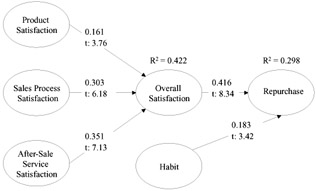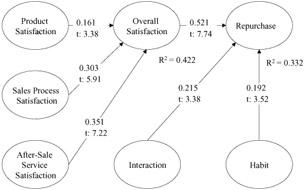Results and Discussion
|
| < Day Day Up > |
|
Figures 2 and 3 provide the results of testing the structural links of the proposed research model using PLS analysis for the main effect model and the interaction model, respectively. The estimated path effects (standardized) are given along with the associated t-values. All path coefficients are significant at the 99% significance level, providing strong support for all the hypothesized relationships.

Figure 2: Main Effects Model.

Figure 3: Interaction Model.
The main effects model explains 29% for the variance of repurchase. The inclusion of the interaction construct (see Figure 3) increases the R-square for repurchase to 33%. The path coefficient between the interaction construct and repurchase is 0.215 and is also significant at the 1 % level. Thus, these results imply that one standard deviation increase in online shopping habit will not only impact repurchase directly by 0.192, but would also increase the impact of satisfaction from 0.416 to 0.521. The interaction effect, therefore, has an effect size f2 of 0.047, which represents a solid small effect, confirming our hypothesis that online shopping habit moderates the relationship between overall satisfaction and repurchase [2]. In other words, as online shopping becomes more habitual, the effect of satisfaction with an online store on repurchase also becomes stronger. Although small, the moderating effect of online shopping habit is significant at the 1% level. These findings imply that companies should focus on consumers who have acquired the habit of shopping online in allocating their marketing efforts, as these consumers are more likely to repurchase when satisfied. That is, the effects of satisfaction on repurchase could be strengthened or weakened by the online shopping habits of the consumers.
Our findings prove that overall satisfaction is an important factor leading to repurchase. Moreover, sales process satisfaction (.303) and after-sale service satisfaction (.351), as indicated by the strength of their path coefficients, seem to be more important than product satisfaction (.161). A possible explanation is that grocery retailers usually carry products with similar attributes but differ in their support for the online shopping processes and their after-sale services. This result is consistent with the common belief that with e-commerce the competition is mainly on the digital value (i.e., information content, online services), rather than on the physical attributes of the product.
Table 1 highlights the important items constituting each of the three types of satisfaction variables. For product satisfaction, all variables including quality of products, prices of products, product choices and product description were found to be significant, except for packaging of product. This is probably because packaging is no longer a concern for grocery products. Prices, as indicated by the relatively higher weight, are the key drivers of product satisfaction as most customers shop online for cheaper products.
For process satisfaction, only privacy measures and convenience of shopping were found to be insignificant, while the rest (transaction efficiency, navigation efficiency, comparative shopping, site accessibility, web page loading speed, security measures and user-friendliness) were all proven to be important. Privacy may not be a major concern for online consumers since buying grocery products is not really revealing. Convenience of shopping may be taken for granted by online customers, as this attribute is offered by all Internet retailers. On the other hand, transaction efficiency and comparative shopping are regarded by customers as the most important factors that led to online repurchase, as indicated by the relatively higher weights. Transaction efficiency refers to the ability of the customers to complete the shopping cycle in a short period of time. Customers want to be able to compare a wide variety of products easily and efficiently on the Internet in order to make more informed decisions in product selection.
For after-sale service satisfaction, customer service and delivery care (unlike delivery time and handling returns) were found to be insignificant. This could be explained by the fact that customer service and delivery care are not important issues for grocery products. On the other hand, delivery time is the key driver of after-sale service satisfaction given the perishable nature of grocery products.
[2]f2 = (.332-.298)/(1-.298)=0.05
|
| < Day Day Up > |
|
EAN: 2147483647
Pages: 207